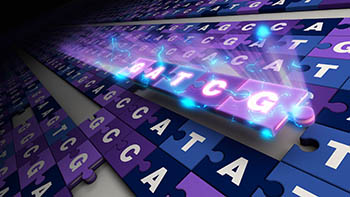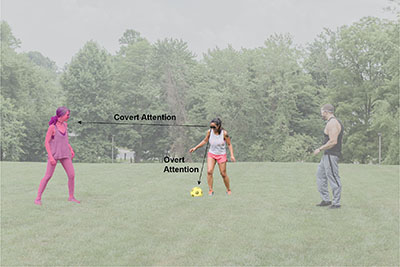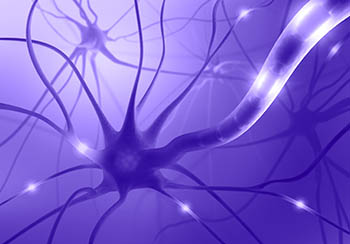Research Briefs
NHGRI, NLM: COMPLETE HUMAN GENOME SEQUENCED

CREDIT: NHGRI
Illustration representing the missing bases (or letters) being inserted into a DNA sequence.
In a milestone scientific achievement, researchers have successfully published a complete human genome sequence. Twenty years after the first draft of a human genome sequence was generated by the Human Genome Project, which was 92% complete, this new version closes the remaining gaps. Named Telomere-to-Telomere CHM13 (T2T-CHM13), the genome adds nearly 200 million base pairs to the approximately three billion pairs that comprise the human genome.
The study was undertaken by the T2T consortium which included leadership from NHGRI, the University of California at Santa Cruz (Santa Cruz, California), and the University of Washington (Seattle, Washington). Playing a critical role in the project were many trainees and early-career researchers from several universities across the country as well as the Howard Hughes Medical Institute (Chevy Chase, Maryland) and the National Institute of Standards and Technology (Gaithersburg, Maryland). Six papers discussing the accomplishment were published in Science.
The new T2T-CHM13 will help studies reveal how people’s DNA differs, and it will aid the understanding of the genetic contribution to certain diseases. “This foundational information will strengthen the many ongoing efforts to understand all the functional nuances of the human genome, which in turn will empower genetic studies of human disease,” said NHGRI Director Eric Green.
The discoveries were made possible by the advent of two new technologies called the Oxford Nanopore and the PacBio HiFi DNA sequencing methods. These strategies enabled the researchers to generate extraordinarily precise and accurate sequences from a single molecule of DNA.
“Truly finishing the human genome sequence was like putting on a new pair of glasses. Now that we can clearly see everything, we are one step closer to understanding what it all means,” said Adam Phillippy, whose research group at NHGRI led the finishing effort. (NIH authors: S. Nurk, S. Koren, A. Rhie, M. Rautiainen, C. Jain, A.M. McCartney, N. Hansen, G.G. Bouffard, S.Y. Brooks, A.C. Young, V.V. Maduro, J.C. Mullikin, V.A. Schneider, F. Thibaud-Nissen, B.P. Walenz, C. Xiao, and A. M. Phillippy, Science 376:Issue 6588, 2022; DOI:10.1126/science.abj6987)
[BY SATABDI NANDI, NIA]
NHLBI: HYDRATION MAY REDUCE LONG-TERM CARDIAC RISK

CREDIT: SHUTTERSTOCK
Older woman drinking water.
Scientists at NHLBI have found that consuming sufficient amounts of fluids not only supports essential body functioning but may also reduce the risk of severe heart problems later in life.
In a retrospective review, investigators analyzed data from over 15,000 individuals ages 45 to 65 who shared information from medical visits over a 25-year period. Those analyzed did not have diabetes, obesity, or heart failure at the beginning of the study. The research team then assessed the hydration status of the participants by looking at blood serum sodium, which increases as the body’s fluid levels decrease.
The authors found that serum sodium concentrations above 142 milliequivalents per liter in middle age were associated with increased risks for developing left ventricular hypertrophy and heart failure later in life. While fluid guidelines vary based on the body’s needs, the researchers recommended a daily fluid intake of 6 to 8 cups for women and 8 to 12 cups for men. (NIH authors: N.I. Dmitrieva, D. Liu, C.O. Wu, M. Boehm, Eur Heart J ehac138, 2022; DOI:10.1093/eurheartj/ehac138)
[BY MICHAEL TABASKO, OD]
NEI: PERIPHERAL VISION ATTENTION NOT DRIVEN BY TINY EYE MOVEMENTS

CREDIT: NEI
While focusing their eyes on a soccer ball (yellow), a player might be paying attention to a teammate (pink) in their peripheral vision. The player’s overt attention would be on the ball, while covert attention would be on the teammate.
How does a basketball player keep their eyes on the person guarding them while also noticing where their teammates are positioned? Scientists have been trying to understand how our brains support covert attention, which is the ability to keep track of things in our peripheral vision. Some have speculated that tiny, involuntary, zig-zagging eye movements known as microsaccades might be the cause. A discovery by NEI researchers offers new evidence to reject this theory, with broad implications for the science of attention.
Previous research has found many examples of brain signals that control convert attention, including in the superior colliculus, deep in the brain. But some scientists were skeptical: What if these brain signals were not actually responsible for covert attention and instead were caused by the microsaccades that occur whenever you look steadily at one location? If true, this would prompt a reevaluation of many prior studies.
To find out, NEI scientists tested covert attention by training rhesus macaques (Macaca mulatta) to keep their eyes fixated on one part of a screen while also tracking objects that appeared in the periphery. The researchers measured microsaccades with an eye camera while recording activity from the superior colliculus. Crucially, they found that brain activity related to covert attention happened before any eye movements occurred and could even happen without microsaccades at all. These findings help resolve a debate, advance our fundamental understanding of attention, and provide insights that could spark future research on attention disorders. (NIH authors: G. Yu, L.N. Katz, and R.J. Krauzlis, eLife 11:e74168, 2022; DOI:10.7554/eLife.74168)
[BY PETER MANZA, NIAAA]
NIDDK: TARGETING FAT-CELL SIGNALING MAY HELP TREAT METABOLIC DISEASE
NIDDK scientists and their colleagues have discovered that selectively activating a class of cell surface receptors known as guanine nucleotide binding protein, alpha q polypeptide (Gq)–coupled receptors on fat cells improved impaired glucose tolerance and insulin resistance in type 2 diabetes (T2D).
Adipocytes (fat cells) play an important role in the development of T2D. Obesity increases the breakdown of fat, a process known as lipolysis, which causes excessive amounts of free fatty acids (FFA) to be released into the blood. Increased plasma FFA concentrations lead to the accumulation of fat in other tissues, which contributes to the impaired glucose tolerance and insulin resistance seen in metabolic disease.
In a recent study, investigators analyzed mouse and human adipocytes that were altered to enhance Gq signaling. Compared with control cells, the modified cells showed inhibited lipolysis and improved glucose uptake.
Improved metabolic effects were mimicked in vivo using mice that were obese and mice that were genetically modified to be insulin resistant. The results demonstrated that activating the Gq signaling pathway had beneficial metabolic effects independent of insulin action.
The authors note that these findings may lead to the development of new therapies that selectively activate Gq-coupled receptors to treat T2D and related metabolic disorders. (NIH authors: T. Kimura, S.P. Pydi, L. Wang, D. Haspula, Y. Cui, H. Lu, O. Gavrilova, and J. Wess, Nat Commun 13:Article number 1652, 2022; DOI:10.1038/s41467-022-29231-6)
[BY MICHAEL TABASKO, OD]
NINDS, NICHD, NIAID, NIA: NEWLY DISCOVERED MOLECULAR PATHWAY IN TWO NEURODEGENERATIVE DISORDERS

CREDIT: NINDS
Illustration of a neuron
Scientists from two independent research teams have discovered a molecular pathway that could be a potential therapeutic target to treat amyotrophic lateral sclerosis (ALS) and certain dementias such as frontotemporal dementia (FTD).
ALS and FTD are two neurodegenerative disorders that have been linked to mislocalized transactive response DNA binding protein 43 (TDP-43), where instead of being primarily located in the nucleus of the cell, where genes are activated, it collects outside the nucleus in multiple neurodegenerative diseases.
The mislocalization of TDP-43 alters the genetic instructions for UNC13A, a gene that is important for maintaining the connections between neurons and has been shown to be a risk factor for both ALS and FTD.
A team of NIH researchers and their colleagues used human stem cells and genetic tools to create neurons that made much less TDP-43 protein than normal. This resulted in the appearance of abnormal sequences of UNC13A RNA transcripts, in turn reducing the concentration of UNC13A protein and directly linking a well-established risk factor for ALS and FTD with the loss of TDP-43.
At the same time, a research team at Stanford University (Stanford, California) and at the Mayo Clinic (Jacksonville, Florida) found the same effects caused by a loss of TDP-43 on UNC13A (Nature 603:124–130, 2022; DOI:10.1038/s41586-022-04424-7). Both studies suggest that developing means to increase the concentration of UNC13A may be effective in preventing the death or dysfunction of neurons. TDP-43 mislocalization is seen in other neurodegenerative diseases including Alzheimer disease and certain encephalopathies. (NIH authors: S.E. Hill, Y.A. Qi, S. Seddighi, J.F. Reyes, S.L. Coon, D. Ramos, and M.E. Ward; New York Genome Center ALS Consortium includes NIH members A. Nath, and S. Muljo, Nature 603:131–137, 2022; DOI:10.1038/s41586-022-04436-3)
[BY MICHAEL TABASKO, OD]
NIA: MACHINE LEARNING SUCCESSFULLY IDENTIFIES ALS SUBTYPES
NIA researchers have developed a set of reliable, ground-breaking machine learning (ML) algorithms that successfully identify and predict clinical subgroups of amyotrophic lateral sclerosis (ALS). ALS, also known as Lou Gehrig’s disease, is a progressive neurodegenerative disease that affects motor neurons, which control voluntary muscle movement. Early-stage symptoms include muscle weakness or stiffness; late-stage symptoms include loss of the ability to speak, eat, move, and breathe. ALS represents a collection of overlapping syndromes, and while various systems to classify subgroups have been proposed, it is unclear how accurately these systems reflect the ALS population.
The investigators applied unsupervised, semisupervised, and supervised ML algorithms to detailed data for 42 clinical features collected from a cohort of ALS patients from the Piemonte and Valle d’Aosta regions of Italy. They then replicated their findings on patient data from a separate cohort of individuals with ALS living in the Emilia Romagna region of Italy.
Of the three algorithms, the semisupervised ML generated the most optimal clustering of ALS patients. These clusters roughly correlated with the six clinical ALS subtypes established by the Chiò classification system (bulbar, respiratory, flail arm, classical, pyramidal, and flail leg). The supervised ML algorithm recognized 11 clinical variables that were important in accurately predicting ALS subtypes. The findings provide insight into the clinical diversity of ALS and could improve clinical care and the design of future clinical trials. (NIH authors: F. Faghri, A. Dadu, M.A. Nalls, and B.J. Traynor, Lancet Digit Health 2022; DOI:10.1016/S2589-7500(21)00274-0)
[BY RAGHURAM REDDY, NINDS]
This page was last updated on Tuesday, May 17, 2022
